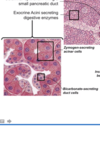Alimentary System Flashcards
(304 cards)
How can vitamins be absorbed into the body?
- Passive diffusion predominant mechanism
- Fat soluble vitamins (A, D, E, K) transported to brush border in micelles. K taken up by active transport.
- Specific transport mechanisms for vitamin C (ascorbic acid), folic acid, vitamin B1(thiamine), vitamin B12
How is mucus production in the large intestine triggerd?
By ACh –> PNS
What is the most common type of cancer in the GI tract?
Which tissue type does it originate from?
It is an Adenocarcinoma (every epithelial cancer from lower esophagus downwards)
It is derive from “glandular epithelium”
When and why is gastrin secretion inhibited?
It is inhibited when pH drops below 3 to protect the duodenal mucosa
What is the effect of Trypsin activation?
Active enzyme –> can break down proteins
Also can activate different pro-enzymes:
- Auto-activation of Trypsinogen
- Activation of Protease zymogens to Protease
- Activation of procolipase to give rise to lipase

What are the symptoms of gilberts syndrome?
Asymptomatic
Jaundice might occur when fasting, dehydration, and in viral ilness
What are the main tasks of the submucosal plexus?
It intrinsically controls:
- endocrine function
- gastrointestinal secretions
- blood flow
What is a portal triad?
The portal triad consists of
- Hepatic portal vein
- Hepatic artery
- Bile duct
It is situated at each corner of a hepatic lobule (hexagon)

How are cells in the large intestine differently organised than cells from the small intestine?
No nutrient absorption takes place —> less surface area needed:
- No villi
- Enterocytes have small, irregular microvilli
- Enterocytes are organised to absorb ions (and drag water passively with it)
What are the advantages and disadvantages of an abdominal X-Ray, a CT scan and a barium enema for investigation of Cholorectal cancer?
X-Ray
- not very specific, can’t detect anything
- but cheap
CT:
- Cheap, quick, good for big tumors
- Not tissue sampling, small leasions might not be seen
Barium enema:
- Unpleasant for patient, no tissue sampling
- But more can be seen than on CT alone
Which role do genetics play in obesity?
Only can explain 5% of obesity
Can influence e.g.:
- appetite regulation
*
What are the three main functions of motility of the small intestine?
- To mix ingested food with digestive secretions and enzymes
- To facilitate the contact between contents and mucosal surface
- To move the contents along the small intestine
By which cell type are the colonic cryps dominated and why?
By goblet cells which produce mucus to:
- to facilitate the passage of increasingly dry luminal contents (as more and more water is reabsorbed)
- ‘covers’ bacteria and particulate matter, to protect the luminal surface from infect and/or abrasion.
Which parts of the oesophagus are supplied by which type of muscle?`

How much water could the large intestine absorbe a day?
Up to 4500ml a day
–> Everything that exceeds that –> Diarrhea
Summarise the circulation of an activated lymphocyte in the GALT

Which role does the liver play in Fat metabolism?
Triglycerides get transformed into fatty acids –> acetyl CoA or Ketones (acetoacetyl CoA)
lipoprotein synthesis (lipogenesis) from glucose/acetyl CoA) and glycerol
Why is trypsinogen and not trypsin secreted?
How is Trypsinogen activated?
By Enterokinase in the duodenum
–> otherwise it would break down all the pancreatic cells (breaks down proteins)
Name 5 signs of liver failure
- Jaundice –> bilirubin
Also the liver has a role in oestrogen metabolism which can cause
- Loss of body hair
- gynaecomastia
- testicular atrophy
- palmar erythema: “liver palms’ - reddening of palms at the thenar and hypothenar eminences
- Spider naevi : central arteriole with radiating small vessels

What are the symptoms of Ulcerative colitis?
Pain in left lower quadrant due to ulcers along the inner surface of large intestine, including the colon and rectum.
Severe and frequent diarrhea (sometimes blood in the stool).


What is distinctive about an activated/inactivated parietal cell?
They have tubulovesicles in inactivated parietal inactivated state with many proton pumps
When activated: the tubulovesicles fuse and secrete HCl
How are the exocrine cells in the pancreas called?
Exocrine acini cells








































































































